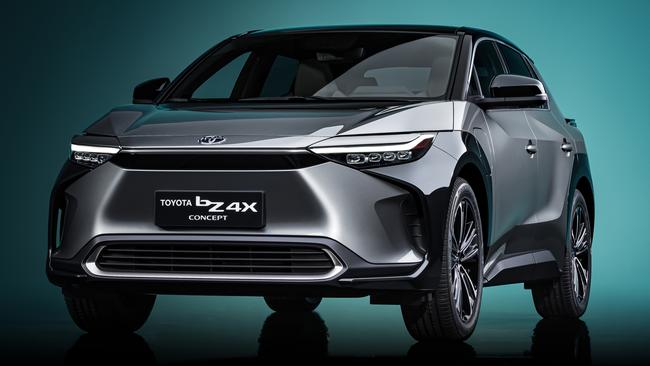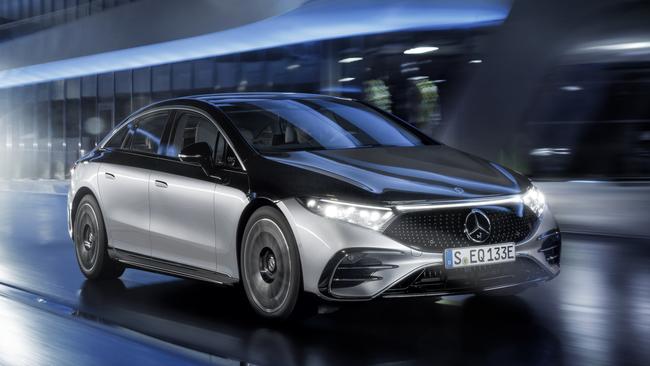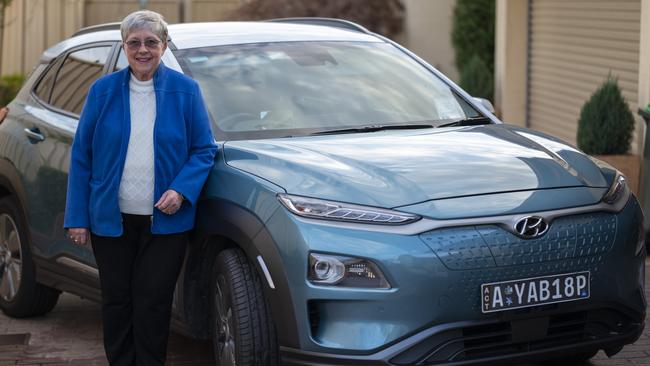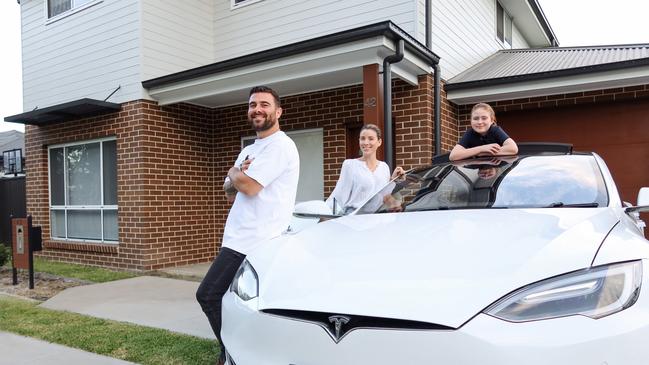New, slick electric cars coming to Australia
Australians are ready for a new type of car with an electric feel. See what the biggest car companies are planning to change how we drive.
Motoring News
Don't miss out on the headlines from Motoring News. Followed categories will be added to My News.
Australian car buyers are ready to flick the switch on electric vehicles, new research shows.
Market research firm Nature surveyed prospective buyers and found more than a third expect to buy some form of electrified vehicle in the next five years.
Of those surveyed, men were more likely to switch, with 44 per cent claiming they were looking at buying an EV or hybrid in the next five years.
The research shows that while hybrid acceptance is growing, barriers remain to widespread EV acceptance.
Most respondents who weren’t considering an EV cited the high purchase cost, a lack of charging infrastructure and long charging times as turn-offs. Some simply said they didn’t know enough about the technology.
That’s likely to change over the next 12 months as the car industry ramps up efforts to market EVs in Australia.
Australia’s number one car company, Toyota, will launch an electric SUV next year.
That will leave Volkswagen and Subaru as the only top-ten selling brands not to offer some form of plug-in vehicle.

Globally the car industry is expected to pull the plug on more than a century of tradition by discarding petrol and diesel engines and embracing electric cars over the next decade.
Tough new emissions laws in Europe and ambitious EV plans in the world’s two biggest car markets, the United States and China, will drive the dramatic change.
For Australians, the transformation seems hard to comprehend. At the moment less than one per cent of our new-car market is electric. High prices, range limitations and a lack of charging infrastructure mean EVs simply don’t make sense to buyers.
But experts believe that will change dramatically in a short period of time as EV tech becomes cheaper and the supply of cheap petrol alternatives begins to dry up.
If you don’t believe it can happen here, take a look at the United States.
Last month, Bill Ford, great grandson of the man who brought motoring to the masses, unveiled an electric version of the legendary F-Series truck.
The symbolism was striking. This was not an awkward, Prius-style hatchback, but the automotive equivalent of apple pie for Americans.

The F150 has been the number one selling vehicle in the US for more than 40 years.
Ford, executive chairman of the brand that bears his name, called it a “defining moment for our country” and “a watershed moment for our industry”.
The F150 Lightning is a beast of a vehicle. It makes a V8-like 420kW of power and 1050Nm of torque, can race from 0-100km/h in 4.5 seconds and can tow four and half tonnes, roughly a tonne more than a Toyota HiLux.
Ford says it will cost less than $US40,000 and be good for 480km between charges.
Aussie Trevor Worthington, the man who once oversaw the development of new Falcons and Territories, now works on EVs in the US and was on hand for the launch.
“Electric is the biggest transition that the industry has been through in 100 years,” he said.
In typical Aussie fashion, Worthington said the launch showed Ford was “not going to be half-arsed” about EVs.
But embracing EVs isn’t as simple as flicking a switch. If Australia was to go electric overnight our grid simply wouldn’t cope. Our EV charging infrastructure is inadequate and most of our electricity is powered by coal. Studies have shown that an EV running on the grid is no greener than an efficient petrol car.
Locally, the car industry is divided. Two of the biggest hitters, Toyota and Hyundai, have very different views on the subject.
Hyundai is adopting the “build it and they will come” approach, launching headfirst into full electric vehicles despite the minuscule sales. It will launch its third EV later this year. Toyota is adopting a more pragmatic approach that involves a transition from hybrid to full electric over the next decade.

Hyundai chief operating officer, John Kett, said that while the company would release hybrid versions of some vehicles in the next year or so, they weren’t a long-term solution.
“Quite frankly we don’t see that as tomorrow’s car … Zero emissions for us is our key priority. We think hybrid is a transitional technology,” he says.
“There’s no doubt that consumers have demonstrated a willingness to go to hybrid on price and the concerns around range anxiety etc. but we feel like the proposition we will be bringing forward around electrification will address that concern,” he said.
The company will launch the Ioniq 5, its first vehicle built from the ground up as an EV, later this year.
Toyota won’t have an EV until next year, when the BZ4 is launched. A pioneer in hybrid technology, it is lagging the competition on EVs.
Sales and marketing boss, Sean Hanley, said there was a reason for that.
He argues that the brand is doing more for the environment by selling tens of thousands of hybrids, rather than a handful of EVs.
Hybrids already make up almost 30 per cent of Toyota sales in Australia and roughly 70 per cent of RAV4 sales.
The company’s dominance of the new-car market (it accounts for one-in-five new-car sales) means one in 15 new cars sold today are hybrid.
“Our view is that eco-friendly vehicles can only make a meaningful reduction in CO2 if they achieve widespread use,” Hanley said.
Toyota believes hybrids, plug-in hybrids, full battery electric vehicles and hydrogen fuel-cell vehicles are all part of the answer.
“We don’t see one particular form of electrification being the silver bullet,” he says.
By 2025, the brand will offer 70 electrified vehicles, but only 15 will be fully electric. It is also trialling a hydrogen fuel-cell car, the Mirai, with local customers, who refuel at a hydrogen generating plant on the site of its former Camry factory in Altona, Victoria.
Hyundai has a similar program running in Canberra and Sydney with its Nexo fuel-cell SUV.
Hanley said the approach was horses for courses. Fuel-cells are likely to work in bigger trucks, trains and ships, while battery electric vehicles will be popular city runabouts.
“In the end the driver of electric vehicle adoption will be the consumer. There’s a very diverse use of vehicles in Australia. The reality is these vehicles must be fit for purpose because ultimately the consumer will decide whether they will adopt electrification based on performance, practicality, capability and affordability,” he says.
Hanley argues that haste could actually result in a worse outcome for the environment.
“One quarter of the world’s CO2 emissions come from electricity generation. Even by 2040 more than half the world’s electricity is expected to be generated by fossil fuels.
“Therefore if all cars were to become battery electric vehicles the demand for electricity would increase and carbon neutrality could be a long way off,” he says.
Ford’s Worthington says it is inevitable that Australia, with its long distances and rural population, will be slower to adopt battery electric vehicles.
But as the scale of EV production builds and fewer petrol cars are built, there will be a crossover point where EVs will make sense.
“The cost of batteries will come down. The cost of motors will come down. And so there is going to be a crossover point. There will be a point where battery vehicles will be cheaper than an internal combustion engine vehicle,” he says.
‘I WOULDN’T GO BACK TO PETROL’
Musician and bar owner Jerome O’Connor has owned a Tesla Model S for five years and has no regrets.
“This is definitely the way of the future and I love it more than I thought I would. I wouldn’t go back to petrol,” he said.
He said he didn’t buy the car as an environmental statement.
“It wasn’t a greenie thing. I’m a techy sort of guy and was drawn to that. I love the over-the-air updates and the way I can unlock it with my phone if I lose my keys,” he said.
“I also like the fact that it’s quick, torquey and looks so good.
Carol Grout-Smith traded in her diesel BMW 3-Series for a Hyundai Kona electric vehicle in 2019.
“I’ve been driving it a while and I love it. I’m saving so much money and it’s beautiful to drive,” she said.

The Kona EV costs about $65,000, which is roughly $30,000 more than the equivalent petrol version, but Grout-Smith wasn’t deterred by the price premium.
“They cost more money because we don’t have enough of them yet,” she said.
The former principal looked at all the EVs available but chose the Kona because it could make the trip from Canberra to Sydney on a single charge.
“You do have to plan your journeys a bit more, but the charging stations are increasing,” she said.
Richard McNeall from Sydney has owned a Model S Tesla since 2016 and has done a lap of Australia in the car.
He would never go back to driving a petrol car after owning the Tesla.
“People say electric cars are impractical but no-one ever goes back. That is the acid test,” he said.
He said range anxiety was less of a problem in his Tesla than a petrol car.
“You just treat it like a mobile phone and plug it in overnight,” he said.
The range of his Model S has dropped by about 25km in the time he’s owned it – EV batteries slowly lose charge like a mobile phone – but he still intends to hang on to it.


